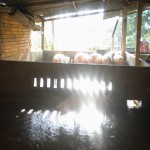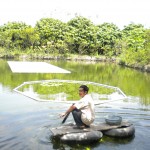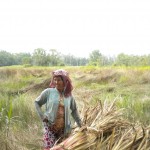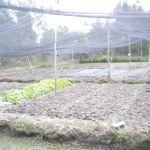I was reminded this past week how good dirt under my fingernails feels… The twelve of us students found ourselves at the Hoa An Biodiversity Center in the Mekong Delta with an amazing team of researchers, farmers, staff members, and three of the luckiest dogs in Vietnam who get to frolic and play in acres of acacia forest and eat our leftovers. We learned about the sustainable farming techniques of the biodiversity center and how they offer this information to the local residents. I cannot describe how it felt to feel a connection to the earth, to farmers, to the immense intelligence of plants in a place that is so far from the familiar.
Dr. Ni founded the center in 1980 on a destitute, barren piece of land. In 1968, the US military used the space for artillery holdings and cannons. Everything except grass was demolished for up to 5 km around the holding. The smaller vegetation that did survive was then destroyed by Agent Orange burning and exposing the soil until Dr. Ni found it decades later. Not until 1990 with the help of fellow restoration specialists could they get anything to take hold in the ravaged dirt. He spoke of the first eucalyptus that took hold with such sweet relief. He explained how, once the tall and lean eucalyptus trees took hold, they could then plant stocky acacia underneath. The eucalyptus became home to the birds; the birds would then plant the seeds they had gathered which would be covered by the organic layer of acacia leaves; the native species found in bird excreta could then begin to grow again.
The research center is this amazing and accessible think-tank of sustainable agriculture in animal husbandry, fishery, and agriculture. This past week, I learned how to install a biodigestor, which turns excreta of pigs and humans into methane gas to fuel their stove, organic fertilizer to feed the algae for their fish and then their orchards. It diverts excreta that would have polluted their local water, replaces chemical fertilizers, provides another fuel source that doesn’t cause deforestation, as well as cuts cost in fertilizer and gas. All you need is 31 meters of heavy plastic, some tubing, and innovative installation. I also learned about a fungus that lives in the Mekong that is now being added to the compost, greatly reducing the time it takes for the organic material to be digested. When it did take 8 months, it now only takes 3 months and ten days.
-
Helpful, happy pigs
-
Collecting algae to feed the fish
-
Farmer working at the Biodiversity Center
-
Small, organic farm
The beauty of the center is that it is made to model a big house. There are no gates, and farmers drink, eat, and live with the researchers. This is not an ivory tower, removed from the people who need this education and experience the most. When students come with proposals about how to integrate catfish and rice farming, they get to work with local farmers who want to learn and be a part of it all too. To Dr. Ni, the key for the success of rural development is making sure the local community is strong enough to adapt with these relentless changing tides of environment fluctuations and the temperamental market economy. The biodiversity center is just one of the many examples of successful grassroots movements.




